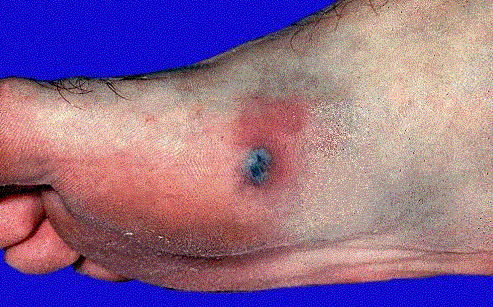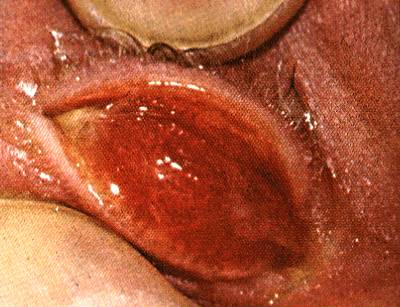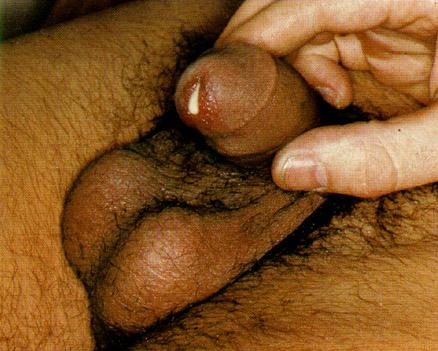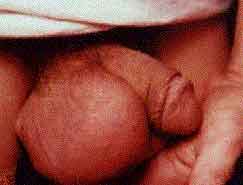Gonorrhea history and symptoms
|
Gonorrhea Microchapters |
|
Diagnosis |
|
Treatment |
|
Case Studies |
|
Gonorrhea history and symptoms On the Web |
|
American Roentgen Ray Society Images of Gonorrhea history and symptoms |
|
Risk calculators and risk factors for Gonorrhea history and symptoms |
Editor-In-Chief: C. Michael Gibson, M.S., M.D. [1]; Associate Editors-In-Chief: Priyamvada Singh, MBBS [2]
Overview
Half of women with gonorrhea are asymptomatic while others have vaginal discharge, lower abdominal pain or pain with intercourse. Most men who are infected have symptoms such as urethritis associated with burning with urination and discharge from the penis. Either sex may also acquire gonorrhea of the throat from performing oral sex on an infected partner, usually a male partner. Such infection is asymptomatic in 90% of cases, and produces a sore throat in the remaining 10%. The incubation period is 2 to 14 days with most of these symptoms occurring between 4–6 days after being infected. Rarely, gonorrhea may cause skin legions and joint infection (pain and swelling in the joints) after traveling through the blood stream. Very rarely it may settle in the heart causing endocarditis or in the spinal column causing meningitis (both are more likely among individuals with suppressed immune systems.
History
In patients with suspected sexually transmitted diseases the following history should be sought:
- Past history of similar symptoms or STDs in patient, current or past partners
- Type of contraception used
- History of sexual assault.
- Menstrual history (date of the last menstrual period, duration. intermittent bleeding, pain)
- Reproductive history (details of parity, including any history of ectopic pregnancies)
Symptoms
- The incubation time varies from 2 to 14 days with most symptoms occurring between days 2 and 5 after being infected from an infected partner.
- A small number of people may be asymptomatic for up to a year. They may be completely unaware that they have caught the disease, and therefore do not seek treatment. This increases the risk of complications and the chances of passing the infection on to another person.
- Between 30–60% of women with gonorrhea are asymptomatic or have subclinical disease.[1]
Genitourinary
Male
- Thick, copious, white, yellow, or green colored discharge from penis (also known as gleet) is the most common presentation.
- Burning and pain while urinating
- Increased urinary frequency or urgency
- Painful or swollen testicles
- scrotal pain or swelling.
- Decreased or abnormal urine stream may suggest stricture (gonorrheal stricture are uncommon these days)
Female
Symptoms in women can be very mild or nonspecific, and may be mistaken for another type of infection. However, even asymptomatic females are prone to have complications due to gonorrheal infection. The symptoms include:
- Vaginal discharge (thin, purulent, and mildly odorous)
- Painful sexual intercourse
- Off-cycle menstrual bleeding, or bleeding after sexual intercourse.
- Increased frequency of urination.
- Burning and pain while urinating
- Severe pain in lower abdomen, fever, nausea, vomiting (if the infection spreads to the fallopian tubes, ovaries, endometrium
- If the infection spreads to the bloodstream, fever, vomiting, rash, and arthritis-like symptoms may occur.
- Pain on right upper side of abdomen (right upper quadrant) may occur due to inflammation of liver (perihepatitis)
Gonococcal proctitis (Rectal)
- It is usually contracted from having rough anal sex. It can be avoided by using toys instead. It may affect both men and women
- Often asymptomatic
- Anal discharge
- Pain on defecating
- Rectal bleeding.
- Pruritus
- Tenesmus
- Bloody diarrhea
Gonococcal pharyngitis
- Caused by oral sex with a partner infected with gonorrhea.
- Usually asymptomatic
- Sore throat
Gonococcal conjunctivitis (ophthalmia neonatorum)
- Bilateral conjunctivitis (redness, discharge, and pain in eyes) is usually seen in neonates and is acquired during vaginal birth from the untreated, infected mother.
- It can lead to complications like blindness if not treated promptly.
- Secondary gonococcal bacterial conjunctivitis may follow accidental inoculation by fingers in either sex and is usually unilateral.
Gonorrhea endocarditis, Meningitis
Very rarely it may settle in the heart causing endocarditis or in the spinal column causing meningitis (both are more likely among individuals with suppressed immune systems.
-
Skin lesion on foot in a patient with Gonorrhea
-
Gonococcal infection of the conjunctiva in a neonate
-
Penile discharge in a patient with Gonorrhea
-
Swollen testes consistent with epididymitis in a patient with Gonorrhea



